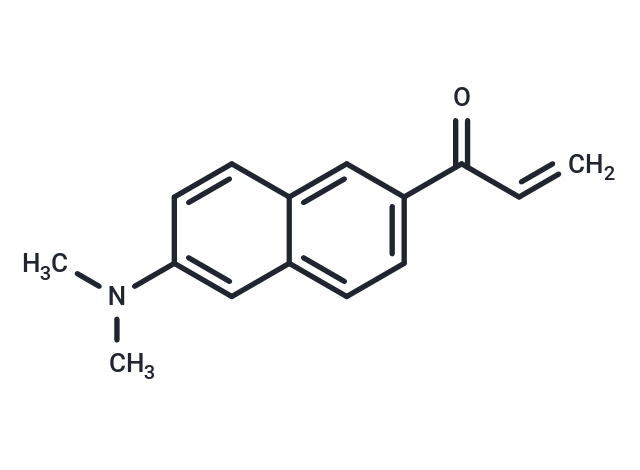Shopping Cart
- Remove All
 Your shopping cart is currently empty
Your shopping cart is currently empty

Acrylodan, when subjected to thiol reactions, exhibits sensitivity to the dipolarity and dynamics of its surrounding binding pocket, specifically those surrounding Cys 34.

| Pack Size | Price | Availability | Quantity |
|---|---|---|---|
| 50 mg | Inquiry | 7-10 days | |
| 100 mg | Inquiry | 7-10 days |
| Description | Acrylodan, when subjected to thiol reactions, exhibits sensitivity to the dipolarity and dynamics of its surrounding binding pocket, specifically those surrounding Cys 34. |
| In vitro | Guidelines recommend a protocol, which should be tailored to specific requirements, for the purification and labeling of Act1. Initially, a 20-fold molar excess of acrylodan (Anaspec) is mixed with polymerized actin and incubated on ice overnight. Following incubation, the actin-acrylodan mixture is centrifuged for 2 hours at 4°C and 100,000 × g. The resultant pellet is subsequently resuspended in a buffer containing 10 mm Tris (pH 7.5), 0.5 mm β-mercaptoethanol, 0.2 mm CaCl2, and 50 μm ATP, and then dialyzed against the same buffer for 70 hours at 4 °C. The supernatant is collected, and the actin concentration along with the degree of labeling are determined using specific extinction coefficients for actin, acrylodan, and Alexa Fluor 488 at their respective wavelengths. The characterization reveals that Acrylodan-labeled Act1 (Acryl Act1 NAT) exhibits significantly distinct properties compared to EDTA-unfolded Acryl Act1 (Acryl Act1I3), the latter having an emission spectrum closely resembling that of CCT-bound Acryl Act1. |
| Molecular Weight | 225.29 |
| Formula | C15H15NO |
| Cas No. | 86636-92-2 |
| Relative Density. | 1.100 g/cm3 (Predicted) |
| Storage | keep away from direct sunlight | Powder: -20°C for 3 years | In solvent: -80°C for 1 year | Shipping with blue ice. |

Copyright © 2015-2025 TargetMol Chemicals Inc. All Rights Reserved.